June 2, 2025 | 10:20 GMT +7
June 2, 2025 | 10:20 GMT +7
Hotline: 0913.378.918
June 2, 2025 | 10:20 GMT +7
Hotline: 0913.378.918
On April 4, delegation from the Department of Water Resources under the Ministry of Agriculture and Rural Development conducted a survey and held discussions with the Department of Agriculture and Rural Development of Dak Lak province to assess water sources and address the dry season drought from 2023 to 2024.
Dak Lak province currently houses 858 irrigation structures, including 619 reservoirs, 161 dams, and 78 pumping stations. Additionally, the province actively supplying water to 151,616 hectares of crop production area, representing only 22.96% of the province's total crop production area.
According to data compiled by the province's Sub-Department of Water Resources, 44 reservoirs have completely depleted their water storage; 139 reservoirs have a capacity below 50%; 135 reservoirs have a capacity from 50% to below 70%; and 127 reservoirs have a capacity above 70%.
Dak Lak province's Department of Agriculture and Rural Development expected that if the current heatwaves continue without rainfall, the water levels in reservoirs and rivers will continue to drop significantly. Notably, small reservoirs in the province are approaching depletion; and due to their relatively old age, sedimentation has severely limited their storage capacity.
Consequently, production areas that receive irrigation water from these reservoirs are extremely likely to experience severe drought by the end of the dry season, with the majority of the affected areas located in the districts of Krong Buk, Ea H’leo, Krong Nang, Lak, Buon Don, Krong Pac, and the town of Buon Ho.
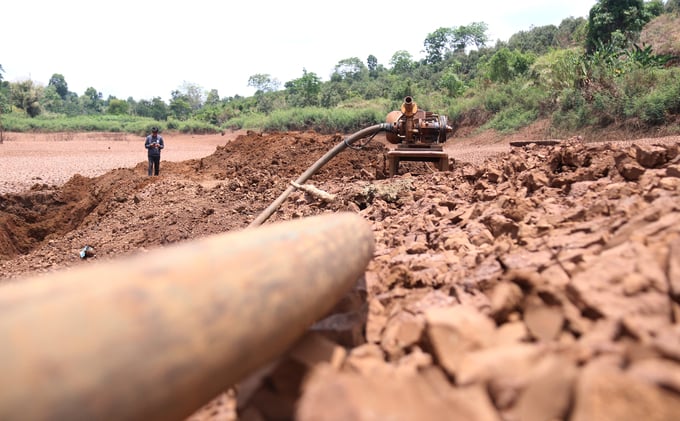
Dak Lak currently houses 44 depleted reservoirs. Photo: Quang Yen.
It is forecast that the water sources at major irrigation structures (Lower Krong Buk, Upper Ea Sup, Buon Joong, etc.) will be able to supply local crop production within the following week. However, medium and small reservoirs (i.e: reservoirs with capacities below 50%), small dams and areas located outside the range of irrigation structures are at risk of water shortage.
Additionally, there is a possibility of localized drought and water shortage at small reservoirs, dams, and areas located outside the range of irrigation structures, with a project affected area of 5,000 to 8,000 hectares.
The province currently hosts 215 rural water supply projects, including 87 incomplete projects and 76 complete but inactive projects.
Notably, three water supply projects managed by the Center for Clean Water and Rural Environmental Sanitation are providing rotational water supply to over 5,000 households in Ea H’leo, Krong Pac, and Krong Bong districts. On the other hand, 531 households in Vu Bon commune, Krong Pac district, and Ea Sin commune, Krong Buk district, are experiencing water shortages. These households are sourcing water from neighboring households.
It is expected that local groundwater and surface water levels will gradually decline over time as water demand grows, resulting in water shortages.
According to Dak Lak province's Department of Agriculture and Rural Development, the province faces significant pressure from the high number of irrigation structures. However, the majority of these structures consist of aging dams and small reservoirs suffering from sedimentation and deterioration, which severely limited their water retention capacity.
On the other hand, certain natural terrain within the province prevents the construction of irrigation structures. As a result, these regions can only produce one irregular crop, and rely primarily on rainfall to provide water for agricultural production or large-scale investments.
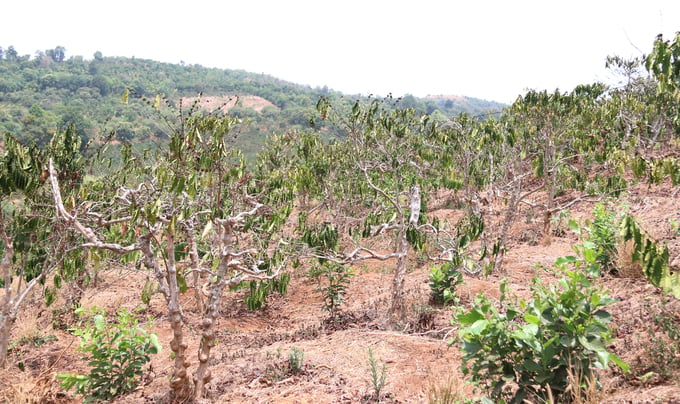
Multiple crop production areas in Dak Lak province are facing sever drought due to a lack of irrigation water. Photo: Quang Yen.
Dak Lak province currently lacks investment funds to upgrade and repair its damaged and deteriorating structures, boosting their safety and effectiveness as a result. Additionally, the asynchronous development of rural water supply projects within the province has failed to meet the water needs of the local population.
According to Mr. Mai Trong Dung, Deputy Director of Dak Lak province's Department of Agriculture and Rural Development, the current water reserve in Dak Lak is estimated at only 200 cubic meters. However, this water is stored across several large reservoirs.
Moreover, Mr. Dung believes that the absence of rainfall until late April 2024 will cause a rapid onset of drought. "The province is currently facing water shortages in coffee, durian, and pepper production areas. These are high-value crops, so people will compete for irrigation water when there is a shortage, leading to faster depletion of rivers and lakes. Although the province's government has developed detailed plans in preparation, the drought is significantly more severe in reality," Mr. Dung said.
According to Mr. Nguyen Thanh Phong, Chairman of the Board of Directors of Dak Lak Irrigation Structure Management Company Limited, the company currently manages 362 irrigation structures.
In anticipation of the drought, the company has proactively developed plans and coordinated with local governments to reduce production areas with insufficient water supply.
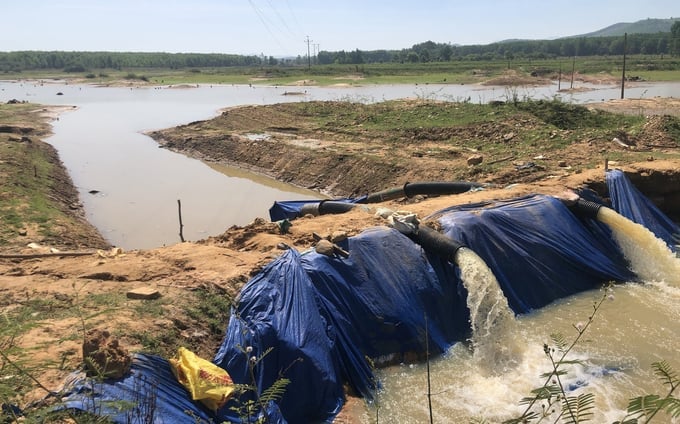
Dak Lak Irrigation Structure Management Company Limited has proactively dredged and pumped water to meet the irrigation needs of local residents. Photo: Quang Yen.
"We consider drought as an adversary, which is why we actively implement measures to ensure water supply for irrigation such as dredging and operating water pumps. However, the company encounters difficulties in terms of payment for drought prevention structures.
The company initially forecast that 63 projects will be affected by the drought; however, there are only 15 diesel pumps available. As a result, the company proposed the local Department of Agriculture and Rural Development to allocate funds for the purchase of an additional 15 pumps for drought prevention. We hope that we will receive additional funding to purchase diesel and electricity to power our water pumps and assist the local residents," Mr. Phong shared.
Mr. Nguyen Thanh Phong further emphasized that the current heatwaves will greatly exacerbate the drought. Consequently, the Department of Agriculture and Rural Development needs to formulate plans and strategies for proactive drought prevention.
Moreover, Mr. Phong proposed the Ministry of Agriculture and Rural Development and the Ministry of Finance to promptly issue guidelines and amendments regarding the pricing of irrigation products and services. On the other hand, deteriorating structures under the management of the company requires funding for repairs to ensure safety during the rainy season.
According to Mr. Nguyen Hong Khanh, Deputy Director of the Department of Water Resources, Dak Lak province has been proactive in developing plans to address the drought. However, Mr. Khanh believes that the drought is significantly more severe compared to the forecast, which will require flexible adjustments in the strategy.
"According to forecasts, the severe drought will last until late April due to the lack of rainfall. According to the approved provincial plan, it is necessary to update and develop plans for each scenario. Immediate measures must be taken to prevent water shortage and protect the affected industrial crop production area from desiccation and wilting." Mr. Khanh added, emphasizing the need to develop scenarios for both the absence and occurrence of drought.

Representatives from the Department of Water Resources inspecting depleted reservoirs in Krong Buk district, Dak Lak province. Photo: Quang Yen.
Mr. Khanh also requested Dak Lak province's Department of Agriculture and Rural Development to provide detailed reports on the affected crop production areas and the extent of the impact.
"We need to forecast what will happen by the end of April if there is no rainfall, including the affected areas and the extent of the impact. Practical actions must be taken to prepare for drought prevention.
The management of irrigation products and services is very challenging. The Ministry of Agriculture and Rural Development and the Ministry of Finance are currently coordinating to find a solution," added Mr. Khanh.
Translated by Nguyen Hai Long
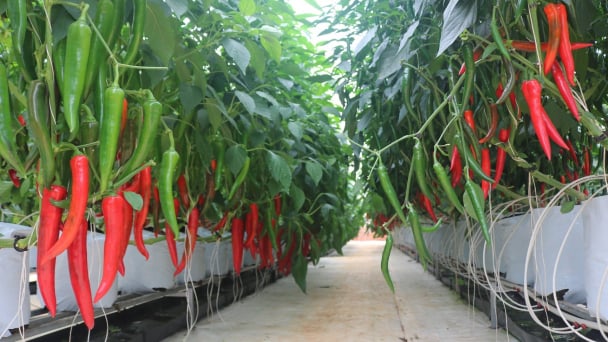
(VAN) Professor Dr. Mai Trong Nhuan believes that Lam Dong will serve as a 'supermarket' of green agricultural products for the entire country and a beautiful destination acting as a 'health charging station' for tourists.

(VAN) A delegation of nearly 50 Vietnamese agencies, agribusinesses, and agricultural associations has officially begun its working trip to the United States.

(VAN) Mr. Van Ngoc Thinh, CEO of WWF-Vietnam, warned that plastic waste is the starting point of a chain of ecological degradation and the decline of coastal livelihoods.
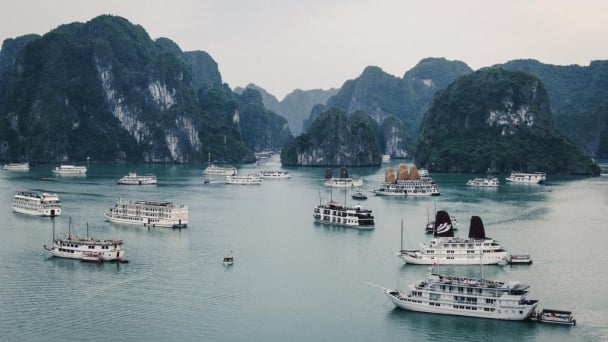
(VAN) Quang Ninh’s leaders have affirmed that the province was one of the first localities in the country to launch a province-wide campaign against plastic waste.
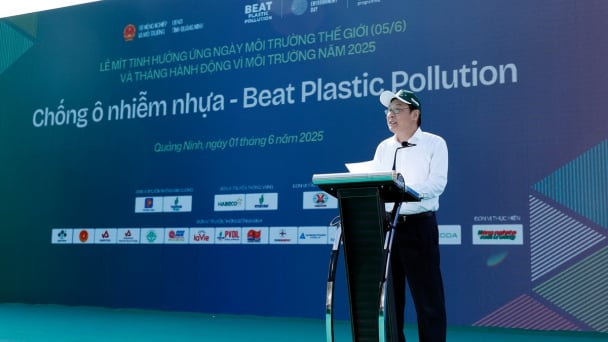
(VAN) Vietnam launches a campaign to reduce plastic waste, aiming for a green lifestyle and a circular economy, joining hands to protect the environment.
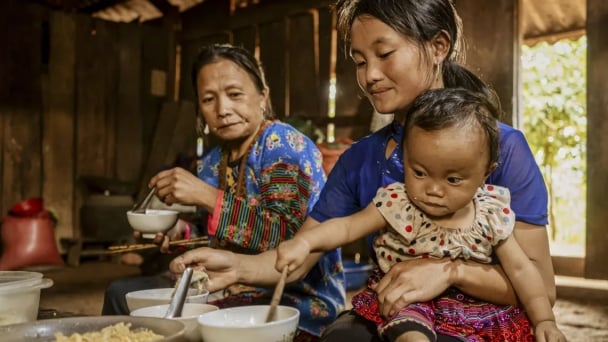
(VAN) 30 experts in health, agriculture and environment participated in a consultation workshop to inform the development of a methodological framework aimed at supporting Vietnam’s transition to a sustainable food system.
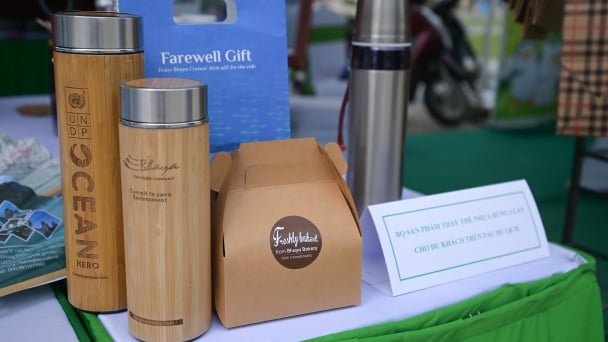
(VAN) Over the past five years, Quang Ninh Province has vigorously and synchronously implemented the ‘Say No to Plastic Waste’ campaign, yielding positive outcomes in advancing sustainable tourism.